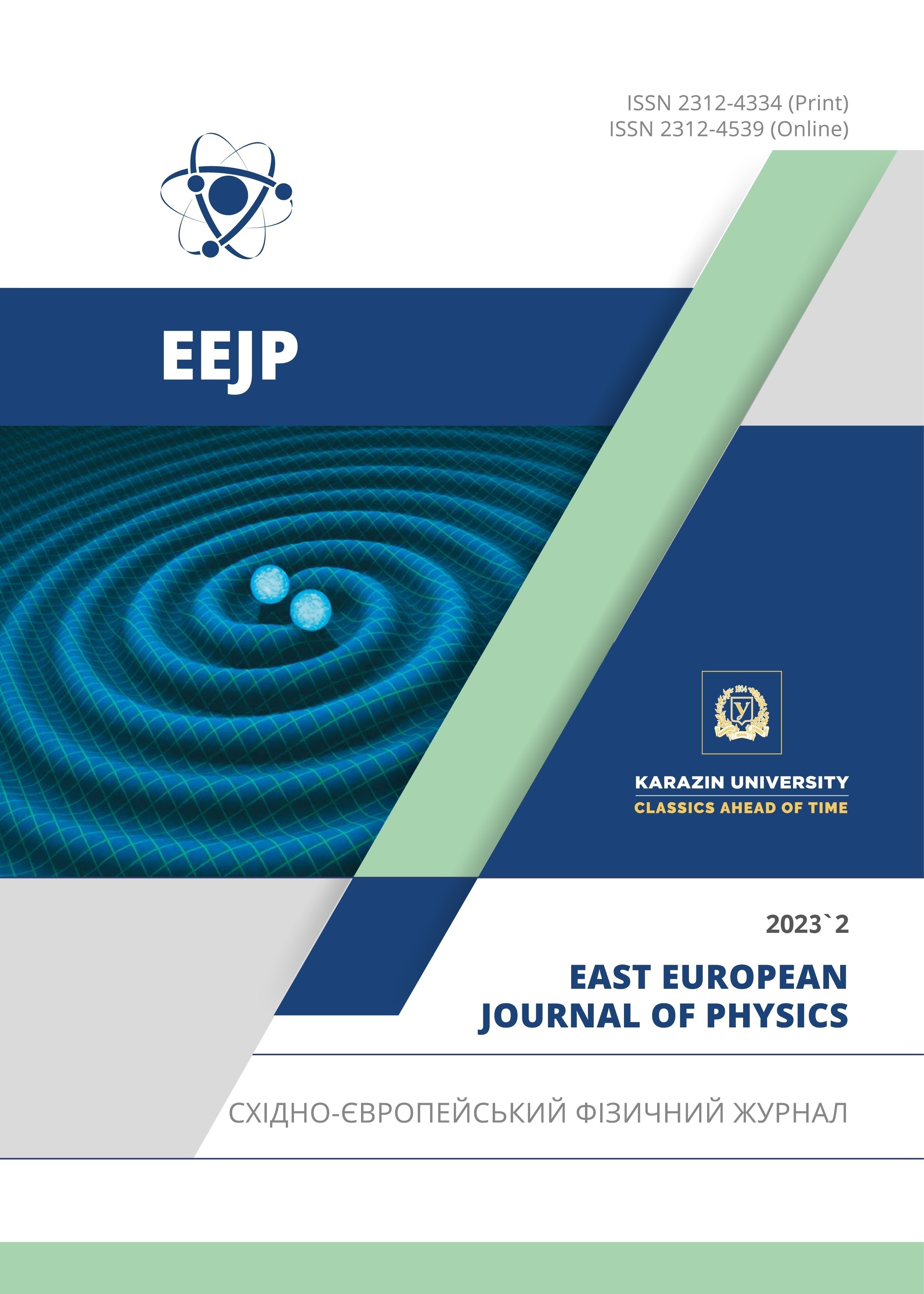Electroexcitation Form Factors and Deformation of 20,22Ne Isotopes Based on the Shell Model and Hartree-Fock plus BCS Calculations
Abstract
Nuclear structure of 20,22Ne isotopes has been studied via the shell model with Skyrme-Hartree-Fock calculations. In particular, the transitions to the low-lying positive and negative parity excited states have been investigated within three shell model spaces; sd for positive parity states, spsdpf large-basis (no-core), and zbme model spaces for negative parity states. Excitation energies, reduced transition probabilities, and elastic and inelastic form factors were estimated and compared to the available experimental data. Skyrme interaction was used to generate a one-body potential in the Hartree-Fock calculations for each selected excited states, which is then used to calculate the single-particle matrix elements. Skyrme interaction was used to calculate the radial wave functions of the single-particle matrix elements, from which a one-body potential in Hartree-Fock theory with SLy4 parametrization can be generated. Furthermore, we have explored the interplays among neutron and proton density profiles in two dimensions, along with the deformations of 20,22Ne using Hartree-Fock plus BCS calculations.
Downloads
References
R. Stock, Encyclopedia of Nuclear Physics, and its Applications, 1st edition, (Wiley-VCH, 2013).
O. Sorlin, and M.G. Porquet, “Nuclear magic numbers: new features far from stability,” Prog. Part. Nucl. Phys, 61, 602-673 (2008). https://doi.org/10.1016/j.ppnp.2008.05.001
R.F. Casten, Nuclear Structure from a Simple Perspective, 2nd edition, (Oxford Univ. Press, New York, 2000).
P. Ring, and P. Schuck, The Nuclear Many-Body Problem, (Springer Verlag, Berlin Heidelberg, 1980).
E. Caurier, G. Martinez-Pinedo, F. Nowacki, A. Poves, and A.P. Zuker, Rev. Mod. Phys. 77, 427 (2005). https://dx.doi.org/10.1103/RevModPhys.77.427
W. Greiner, and J.A. Maruhn, Nuclear Models, (Springer, 1996).
J.B. Mc.Grory, and B.H. Wildenthal, Phys. Rev. C, 7, 974 (1973). https://doi.org/10.1103/PhysRevC.7.974
J.E. Garcia-Ramos, M.V. Andrés, J.A.L. Valera, and A.M. Moro, editors, Basic Concepts in Nuclear Physics: Theory, Experiments and Applications, (Springer, Span, 2018). https://doi.org/10.1007/978-3-030-22204-8
R.A. Radhi, A.A. Alzubadi and A.H. Ali, Phys. Rev. C, 97, 064312 (2018). https://doi.org/10.1103/PhysRevC.97.064312
P.J. Brussaard, and P.W.M. Glaudemans, Shell Model Appli ations in Nuclear Spectroscopy, (North Holand, Amsterdam, 1977).
R.A. Radhi, A.A. Alzubadi, and N.S. Manie, Phys. Rev. C, 97, 1 (2018). https://doi.org/10.1103/PhysRevC.97.024316
D. Vautherin, and D.M. Brink, Phys. Rev. C, 5, 626 (1972). https://doi.org/10.1103/PhysRevC.5.626
T. de Forest, and J.D. Walecka, Adv. Phys. 15, 1 (1966). https://doi.org/10.1080/00018736600101254
A.A. Alzubadi, and R.A. Allawi, Indian J. Phys. 96, 1205 (2022). https://doi.org/10.1007/s12648-021-02052-x
A.A. Alzubadi, Indian J. Phys. 89, 619 (2015). https://doi.org/10.1007/s12648-014-0614-3
P.-G Reinhard, B. Schuetrumpf, J.A. Maruhn, “The Axial Hartree–Fock + BCS Code SkyAx,” Comp. Phys. Comm. 258, 107603 (2021). https://doi.org/10.1016/j.cpc.2020.107603
B.A. Brown, and W.D.M. Rae, Nucl. Data Sheets, 120, 115 (2014). https://doi.org/10.1016/j.nds.2014.07.022
A. Magilligan, and B.A. Brown, “New isospin-breaking “USD” Hamiltonians for the sd shell,” Phys. Rev. C, 101, 064312 (2020). https://doi.org/10.1103/PhysRevC.101.064312
National Nuclear Data Center (NNDC), Brookhaven National Laboratory, Upton, NY, 11973-5000, http://www.nndc.bnl.gov/
B. Pritychenko. M. Birch, B. Singh, and M. Horoi, Atom. Data Nucl. Data Tab. 107, 1 (2016). https://doi.org/10.1016/j.adt.2015.10.001
W.A. Richter, S. Mkhize, and B.A. Brown, Phys. Rev. C, 78, 064302 (2008). https://doi.org/10.1103/PhysRevC.78.064302
S. Mitsunobu, and Y. Torizuka, Phys. Rev. Lett. 28, 920 (1972). https://doi.org/10.1103/PhysRevLett.28.920
X.K. Maruyama, F.J. Kline, J.W. Lightbody, Jr., S. Penner, W.J. Briscoe, M. Lunnon, and H. Crannell, Phys. Rev. C, 19, 1624 (1979). https://doi.org/10.1103/PhysRevC.19.1624
A.I. Steshenko, Nucl. Phys. A, 445, 462 (1985). https://doi.org/10.1016/0375-9474(85)90452-X
A. Obertelli, and H. Sagawa, Modern Nuclear Physics from Fundamentals to Frontiers, (Springer Nature, Singapore, 2021).
R.P Singhal, H.S. Caplan, J.R. Moreira, and T.E. Drake, Can. J. Phys. 51, 2125 (1973). https://doi.org/10.1139/p73-278
Copyright (c) 2023 Omar A. Alswaidawi, Ali A. Alzubadi

This work is licensed under a Creative Commons Attribution 4.0 International License.
Authors who publish with this journal agree to the following terms:
- Authors retain copyright and grant the journal right of first publication with the work simultaneously licensed under a Creative Commons Attribution License that allows others to share the work with an acknowledgment of the work's authorship and initial publication in this journal.
- Authors are able to enter into separate, additional contractual arrangements for the non-exclusive distribution of the journal's published version of the work (e.g., post it to an institutional repository or publish it in a book), with an acknowledgment of its initial publication in this journal.
- Authors are permitted and encouraged to post their work online (e.g., in institutional repositories or on their website) prior to and during the submission process, as it can lead to productive exchanges, as well as earlier and greater citation of published work (See The Effect of Open Access).








